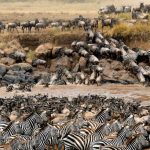Pemba Island in Tanzania
Pemba Island in Tanzania
Pemba Island in Tanzania : also known as “Jazirat al-khudrah” in Arabic literally meaning the green island and also known as “Pemba Kisiwa” in Swahili is a Tanzanian island forming part of the Zanzibar Archipelago, lying within the Swahili coast in the Indian Ocean in its capital Chake-Chake. The island is part of the semi-autonomous Revolutionary Government of Zanzibar and it is administratively divided into two regions; the North Pemba (Pemba Kaskazini) with its capital at Wete which is the largest city and the South Pemba (Pemba Kusini) with its capital at Mkoani. Pemba island is with the exception of a strip of land of cloves, mangoes and hillocks lush with fruit and tree species. It has been long known as the “Green Island” in the Eastern coast due to its fertile soil where locals grow their crops like coconut, bananas, red beans, rice and cassava. The traditional dhows lie scattered across most of the coastline and fishing is a large part of Pemba’s culture.

The island is surrounded with warm sub-tropical waters renowned for some of the best diving and snorkeling in the whole archipelago because of its steep drop-offs, colorful coral reefs and undisturbed marine life. It has been designated as an important bird area by “Bird Life International” because it supports a big population of Pemba green pigeons, Pemba scops owls, Pemba white eyes and Pemba sunbirds. Culture at the island has also been influenced by the Arab traders from Oman and the Original inhabitants who lived on this island for centuries. The island offers dives which are world class and the best along the entire East African coastline with a range of levels all the way from beginners to advanced.
Climate
Pemba Island has a tropical climate with two rain seasons. The most rainfall coming between April and May and smaller rain season coming between November and December. Drier months are January to February and a longer drier season is between June to October.
Attractions on Pemba Island
Fishing

The island is famous for its rich fishing grounds. There is a deep 50 kilometers wide Pemba channel between the island and the main land which is one of the most profitable fishing grounds for game fishing on the Swahili Coast. You will be given an opportunity to target six different billfish species including black, blue and striped marlin.
Agriculture
Pemba island is with the exception of a strip of land along its Eastern coast, a very fertile place to keep it within the Global Farming Industry. A large segment of Zanzibar export earnings comes from cloves. Other primary crops include rice, coconuts, red beans, bananas as well as cassava.
Wildlife
Tourists should pay a visit to the Kidike Flying Fox Sanctuary which is a home to over 4,000 endemic Pemba flying foxes. You can also see these foxes on the walking trails of Ngezi Forest Reserve which also provides a safe harbor for red colobus monkey, Vervet monkeys and a hosts different bird species.
Cultural experience
Join a village tour and learn how rural communities cook, fish and manufacture the goods they need to survive on a daily basis. You can also opt to visit the old fort and slave port of Chake-Chake. Don’t miss to visit the farms and discover how the clove stems are turned into essential oil at the Clove Oil Distillery since cloves are Pemba’s biggest export and there are more than 3.5 million clove trees growing on the island’s spice farms.
Prison Island
Prison island may not sound like the most attractive place in the world but this tropical paradise is the perfect place to escape from the hustle of the main Zanzibar and relax in the sun. Taking its name from the fact that it is a former prison for slaves, this field of natural beauty holds all kinds of pleasure including many giant tortoises that roam freely around the islands. One can reach the island from Zanzibar by use of boat which is approximately 30 minutes.
Scuba diving

Pemba island is one of the most rewarding dive destinations in Africa although it is ringed by coral reef on all sides. Most of its dive sites are located off the west coast where the land plunges hundreds of metres into the deep waters of the Pemba channel. With pinnacles and magnificent submarine walls, the island’s underwater topography provides a natural habitat for all kinds of sea creatures such as Reef sharks, Napoleon wrasse, Turtles and Big game fish.
Pemba museum
Filling an 18th century Omani fort, which was built on the remains of a 16th century Portuguese garrison, this small museum has well organized displays on island history. You will get a lot more information out of your visit to the ruins at places like Ras Mkumbuu if you tend to make a stopover at the museum.
Mud bath
This is one of the unique attractions that Pemba Island has got to offer. This activity has got several health benefits for you for example for starters, mud is rich in minerals and nutrients that will not only remove toxins from their bodies but also release all of the stress that hides inside bodies.
Why Pemba Island is a top tourist attraction
Pemba island is one of the 10 best dive sites in the world. It has got a wonderful scenery, hilly green, very fertile land and is surrounded by numerous smaller islands and coral reefs.
How to get there
You can fly to Pemba Island from Arusha, Dar es Salaam and Zanzibar with the latter journey taking approximately 30 minutes.











It is approprite time to make some plans for the future and it’s time to be
happy. I have read this post and if I could I want to
suggest yoou feew interesting things or advice.
Perhaps you could write next articles referring to this article.
I wish to read more things about it! https://Casinovavada.Blogspot.com/2021/12/blog-post.html